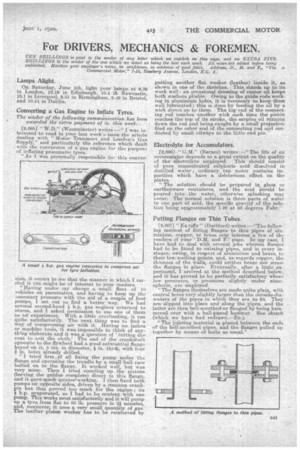For DRIVERS, MECHANICS & FOREMEN.
Page 27

If you've noticed an error in this article please click here to report it so we can fix it.
Lamps Alight.
On Saturday, June 5th, light your lamps at 9,39 in London, 10.19 in Edinburgh, 10.4 ilk Newcastle, 10.1 in Liverpool, 9.51 in Birmingham, 9.-29 in Bristol, and 10.44 in Dublin.
Converting a Gas Engine to Inflate Tyres.
The sender of the following communication, has been awarded the extra payment of 58. this week.
[2,095] " W.D." (Westminster) writes :—" I was interested to read in your last week's issue the article dealing with "Motor Transport and London's Gas Supply," and particularly the reference which dealt with the conversion of a gas engine for the purpose of inflating pneumatic tyres. "As I was personally responsible. for this convex.; sion, it occurs to me that the manner in which I carried it out might, be of interest to your readers.
"Having under my charge a small fleet of 10 vehicles on pneumatics, and having to keep up the aecessary pressure with the aid of a couple of foot pumps, I set out to find a better -isay. We had several second-hand h.p. gas engines returned to stores, and I asked permission to use one of them as an . experiment. With a little overhauling, it ran quite satisfactorily. The next. thing was to find a way of compressing air with it. Having no lathes or machine tools, it was impossible to think of authing elaborate and it was a question of 'cutting this coat to suit the cloth.' The end of the crankshaft opposite to the flywheel had a goad substantial flange keyed on it, 4 ids. m diameter, in. thick, with four # in. holes already drilled.
"I tried first of all fixing the pump under the flange and operating the treadle by a small ball race bolted on to the flange. .It worked well, but was very noisy. Then I tried counling up the pistons (leaving the guides complete) direct to this flange, and it gave much quietertworking. I then fixed both pumps on opposite sides, driven by a common crankpm but that proved too much for the engine; its
h.p. evaporated, so I had to be content with one pump. This works most satisfactorily audit will pump up a, tyre from flat to 80 lb. pressure in • 2i minutes, and, moreover i it uses a very small quantity of gas. The leather piston washer has to be reinforced by putting another flat washer (leather) inside it, as shown in one of the sketches. This stands up to its work well an occasional dressing of castor oil keeps both washers pliable. Owing to the guide rods working in aluminium holes, it is necessary to keep them well lubricated; this is done by feeding the oil by a wick direct on to them. The big end of the connecting rod touches another wick each time the piston reaches the top of its stroke, the surplus oil running down the rod and beingkaught by a.sniall projection filed on the other end of the 'connecting rod and conducted by small oilways to the little end pin."
Electrolyte for Accumulators.
[2,096] " G.M." (Barnes) writes :—" The life of an accumulator depends to a great extent on the quality of the electrolyte employed. This should consist of pure concentrated sulphuric acid dissolved in distilled water ; ordinary tap water contains impurities which have a deleterious effect on the plates.
"The solution should be prepared in glass or earthenware containers, and the acid should be poured into the water, otherwise splashing may occur. The normal solution is three 'parts of water to one part of acid, the specific •gravit§ of the solution being apjgoximately1.26 at 60 degrees Fahr."
Putting Flanges on Thin Tubes.
[2,097] " Ex-tiffy " (Dartford) writes :—"The following method of fitting flanges to thin pipes of aluminium, copper, or brass may interest a few of the readers of your D.M. and Y.' page. In my case, I have had to deal with several jobs wherein flanges had to be fitted to existing pipes, and in every instance, owing, in respect of aluminium and brass, to their low,melting points, and, as ,regards copper, the thinness of the walls, could neither braze nor screw the flanges in place. Eventually, after a, little experiment, I arrived at. the method described below, and it has proved to be perfectly satisfactory where low pressures, or pressures slightly under atmospheric, are employed. 'The flanges theinselpes are made quite plain, with central holes veryslightly larger than the outside,diameters of the pipes in which they are to -fit. They are slipped into place and along the pipes, and the latter are then bell-mouthed.or flanged by-being hahimered over with a ball-paned hammer. See sketch (which we have had redrawn.—En.). "The jointing material is placed between the ends ofthe bell-mouthed pipes, and the flanges pulled up together by means of bolts as usual."




























